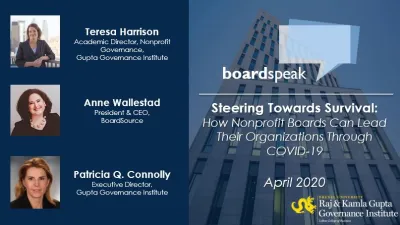
The Business of Nonprofits
A conversation between The Raj & Kamla Gupta Governance Institute Academic Director Teresa Harrison and Executive Director Patricia Connolly
The nonprofit sector is facing unparalleled challenges. New research demonstrates that numerous nonprofit organizations lack the strategy, financial stability and leadership to endure as businesses. The Raj & Kamla Gupta Governance Institute is changing the conversation on how the business of nonprofit organizations is thought of and discussed. Teresa Harrison, Academic Director of Nonprofit Governance at the Gupta Governance Institute, holds a PhD in Economics and studies nonprofits from an economic and industry focused angle. Executive Director Patricia Connolly sat down with Harrison for a conversation around the business of nonprofits and how studying them through this lens can improve our understanding of the current challenges they face while providing insight into possible solutions.
Connolly: According to a recent study on the financial health of Philadelphia-area nonprofits by The Philadelphia Foundation, less than 40 percent are financially strong. What has led to this uncertain landscape and financial difficulties?
Harrison: Overall, it’s fair to say that the industry is distressed. While the Philadelphia Foundation’s study focused on the Philadelphia region, similar results have been found in other major cities as well. Resources for nonprofits are tapped out, and there is not enough to support all the organizations out there.
"Nonprofit organizations don’t operate to make a profit, but they cannot operate at a profit of zero; they need money to remain solvent, to invest, and to make capital improvements."
There is a growing concern that there is duplication and redundancy between nonprofit organizations. When you’re running a business, there is some form of fixed cost associated. Though they may be smaller scale than those of for-profits, nonprofits have costs associated as well. Even though each nonprofit organization is performing valuable work, they might be functioning at a scale that is smaller than the costs. Situations like this take up valuable resources in the nonprofit world, and as a result we often have multiple struggling organizations.
Nonprofit organizations do not operate to make a profit, but they cannot operate at a profit of zero; they need money to remain solvent, to invest, and to make capital improvements. There must be positive return or net income to re-invest into the organization, a critical step to growth and continued success.
Connolly: It’s critical that nonprofit boards provide strategic oversight of their organizations. What steps can the board take to ensure that their nonprofit organization is set up for success, particularly financially?
Harrison: Nonprofits need to utilize their board members’ expertise and business experience. Nonprofit boards are often donor-based and can be larger than for-profit boards of directors. Many nonprofits continue to use their board members solely for fundraising, but they must go beyond this to be successful. Nonprofits need their board members to do more than show up; they need to use their knowledge of the business realm to help the organization and serve as strategic resources.
Board members should bring their business acumen to the table and assist the nonprofit in the same way that they do their corporate boards. Nonprofits should use their boards to develop exit strategies and business plans to ensure financial success. Boards shouldn’t think it inappropriate to discuss and examine the organization’s financial outlook candidly. They should be thinking about what resources are available, what resources are or are not well-deployed, and if there are sufficient staff and infrastructure in place to support the strategic mission.
“Board members should bring their business acumen to the table and assist the nonprofit in the same way that they do their corporate boards.”
Connolly: How and why should nonprofits examine themselves from a business perspective?
Harrison: It’s crucial that nonprofits evaluate themselves through a business lens. 15 years ago, this view was seen as callous, and it was not acceptable to think about the business of nonprofits. Today, we’ve seen a change in that attitude. Nonprofits must consider their financials, their business plan, their strategy, and their differentiation factor—the same things that for-profits must consider.
Many nonprofits were founded because an individual saw an unmet need and had an idea to address it. The desire to help should not negate the need to ask, “What is the best or most impactful way for me to contribute?” Nonprofits can still accomplish their mission to serve while considering their business strategy. The two should not be mutually exclusive. It does not negate the heart of the organization or trivialize the mission to consider your nonprofit as a business, and we need to get away from that thinking.
“The desire to help should not negate the need to ask, ‘What is the best or most impactful way for me to contribute?’”
If you were starting a for-profit organization, you would do market research to understand the landscape and current competitors before diving in. We often don’t ask those questions in the nonprofit world, but nonprofits should be performing the same environmental scan. They must consider their market landscape, possible overlap with other organizations, how they scale up, and possible alliances or associations that may help—both complementary ones and the competition. It may ultimately be better to align with an existing organization than to form a new one, and that is okay.
We must normalize the idea that a nonprofit shutting down, or merging or aligning with another organization does not mean that the mission has failed. Instead, we should view this as a natural evolution of the organization. In the for-profit space, a startup’s sale is considered a success; there is no reason why we can’t think the same way for nonprofits. We should be providing more mechanisms for nonprofits to exit gracefully and successfully to the benefit of their clients if that is the best economic decision.
Connolly: As discussed, many nonprofits struggle to be economically viable, and many do not have sustainable models for their continued survival. What have you observed as far as exit strategies for nonprofits?
Harrison: In my research, I have documented low exit rates across all sub-sectors of the nonprofit space. Based on a number of firms, nonprofits are growing at a faster rate than both public and private for-profit organizations. However, the data indicates that the entry rate is reasonably similar for both nonprofit and for-profit businesses. What is different is the exit rate: nonprofits are three times less likely to exit than for-profits. The result is a larger net entry rate for nonprofits that continues to grow. Additionally, nonprofits are growing at a faster rate with no faster rate of resources. The dollar amount of donations or income has increased, but has remained the same as a percent of GDP.
Connolly: In the for-profit sector, businesses have exit strategies. Why can’t nonprofits look to the for-profit sector for guidance?
Harrison: There are a few barriers to nonprofit exit strategies. Nonprofits are more constrained than for-profits in what they can do if the organization seems like it will not be viable. When a for-profit business is no longer viable, they can liquidate their assets. However, nonprofits do not share this ability. Once deemed nonprofit, their assets are forever classified as such. For example, nonprofit hospitals that have been acquired by for-profit hospitals have often set up foundations related to nonprofit assets.
We want to incentivize and encourage innovation, whether it’s new products, organizations, or services. But we also need to be cautious about the resulting growth and competition for scarce resources that can result. We want nonprofits to care about their mission, but this naturally also means that some are less likely to exit the industry when they are not succeeding.
Connolly: There is a growing need for and interest in research in the nonprofit sector, which you have been studying for many years. What drew you to study this sector?
Harrison: I have always been interested in the nonprofit sector. Historically, most research on nonprofit organizations has been done through a government or public policy orientation. However, my background allowed me to view the sector through the lens of an economist, and I began to study nonprofits from this point of view. I believe we need to study nonprofits from this angle to gain a more comprehensive understanding of the sector.
My research looks at how nonprofits are different from for-profits, and how those differences impact the industries in which they operate. The nature of nonprofits is just different enough from their for-profit counterparts that we need to analyze what aspects are similar, as well as some of the nuanced differences. Although we cannot blanketedly apply for-profit business practices to nonprofits, some practices may be more applicable than we initially think in improving the financial health of the nonprofit sector.
Connolly: The Center for Nonprofit Governance within the Gupta Governance Institute is a new venture. Why is a Center with a focus on nonprofit governance in an academic institution important and how can it have an impact on the sector?
Harrison: The Center is unique in that it’s focus is on the role of the board in providing effective oversight to ensure nonprofits are able to succeed. Most University programs or centers that study nonprofits have a public policy or government orientation or connection. That public policy lens is important, but we also need to study nonprofits from a business perspective, and this idea is perhaps more relevant today than ever before. Although nonprofits are typically mission-driven rather than profit-minded, it doesn’t mean that we shouldn’t think about how nonprofits can best function as a business. The Gupta Governance Institute and Center for Nonprofit Governance’s location within Drexel’s LeBow College of Business demonstrates our distinctive approach to studying nonprofit governance.
Teresa Harrison Academic Director, Raj & Kamla Gupta Governance Institute Associate Dean for Academic Affairs and Innovation, Drexel University LeBow College of Business Teresa Harrison is an Associate Professor in the Department of Economics and International Business at LeBow College of Business at Drexel University. She is an applied microeconomist with interests in nonprofit and hospital behavior and applied microeconometrics. Her research on hospitals and nonprofits has mostly focused on dynamic issues within these industries, including location decisions, entry, exit, mergers, and growth. Since approximately 60% of hospitals are nonprofits, these two lines of research are further connected. Several of Dr. Harrison’s papers explore organizational differences between nonprofits and for-profits and the possible consequences for market structure. She has also examined how tax policies affect the location decisions of nonprofit organizations. Although much of Dr. Harrison’s work has contributed to our understanding of nonprofit market structure and behavior, she would now like to focus on how the presence of nonprofits in the area directly impacts the communities they serve.
Patricia Connolly Executive Director, Raj & Kamla Gupta Governance Institute
Patricia Q. Connolly is an executive with notable success guiding discussions on how to lead and govern in the 21st century. Ms. Connolly’s background is a rare blend of corporate and nonprofit leadership. During her early career, she advanced through a series of positions at financial services firm PNC Financial Corp, culminating with her role as Vice President for the firm’s retail and private banking group. Ms. Connolly then applied her business acumen to the nonprofit sector, holding executive roles at prominent institutions such as the Philadelphia Museum of Art. Since 2008, Ms. Connolly has served as Executive Director for Drexel University’s Raj & Kamla Gupta Governance Institute. Although situated in the academic arena, she has been heavily involved with the for-profit and nonprofit sectors while consulting various Boards of Directors. Regarded as an influential thought leader, she enjoys the chance to guide companies through pivotal decisions and periods of major change.


